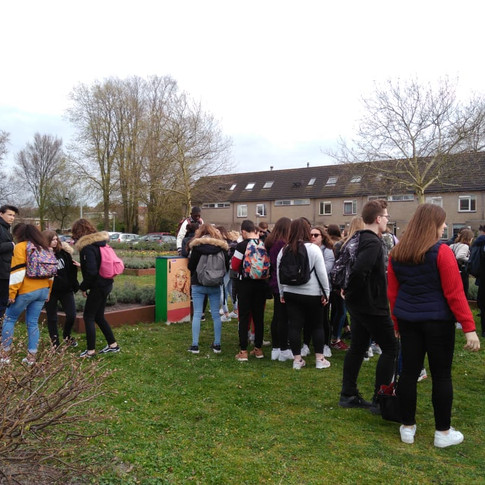Street Art in Amsterdam: City vs Nieuw-West
- Julia Dessauvage & Nora Souici Alin
- Apr 10, 2019
- 3 min read
After a full day of visiting both centre of Amsterdam and the SAMA collection in Nieuw-West to see the street art in the city with a secondary school from the French region Champagne, here we come to debrief on this wholesome experience. Our own observations and the irresistible reactions from the teachers, and especially from the students, led us to highlight several interesting conclusions on this visit that we would like to share here and now.

"When I grow up, I will live in Jordaan!"
This enthusiastic reflexion from one of the students illustrates the most striking contrast that we had to notice between reactions towards an unprecedented visit in the capitale city center and the routine visit of the SAMA collection. Indeed, there is an obvious difference between the historical inner centre (the cute crooked 17th century houses in the Prinsengracht area) and the museum’s territory (social housing’s modern constructions in Slotermeer district) which the teenagers immediately turned out to notice.

Beyond the architectural aspect of the city lies the importance of space management: a narrow canal bank does not offer the perspective that a vast crossroad does. Therefore, the artworks’ type of production won’t be the same in both neighbourhoods, which results in a different reception of them. For instance, the lack of space in Joardaan could explain the abundance of small stickers, whereas a designed route full of huge murals like Glory can only be seen in Nieuw-West.
"It must require a lot of organisation to paint a big mural like that!"
By saying this, one student expressed his impressment about the ongoing new fresco from Bastardilla among SAMA collection. Indeed, a mural that big requires some organisation, as opposed to wilder street-art production you could observe in Amsterdam center, where you need to paint quickly by fear of getting caught, and where the priority does not go to creating a coherent ensemble with the rest of the decor. Where the museum collection follows a geographical and thematic common thread previously defined by mutual agreement between the artists and the museum, Jordaan’s street-art pieces reflect the individual momentum and impulse of the artists.
"Why don’t you take the artworks off the walls before destruction to keep them?"
This is a recurring question that we have mainly been asked from the teachers. As street-art is fundamentally ephemeral, the answer could probably be that searching to conserve these artworks would go against the very essential core definition of what this artistic current stands for.

However, the fact that the SAMA collection is part of a durable and for most legal pieces, makes the artworks able to live a little bit longer than most of the inner city ones, which will be cleaned from one moment to another. Nevertheless the SAMA structure cannot protect the artworks forever, as the urban dynamic is always active, especially in Nieuw-West, which is currently in perpetual reconstruction due to gentrification.
"When were those houses built?"
A historical cityscape leads to historical discussions: Dutch Golden Age, Anne Frank’s childhood, Canal Ring’s merchant past. Ancient History lies here. The Nieuw-West cityscape implies social discussions: immigration since the 50s, expansion of the city chart, municipality social policies. Contemporary History lies here and real people, human bonds, give life to it. SAMA is deeply involved in the social community of Slotermeer indeed, both in an artistic and associative way. If you want a history lesson go to Dam Square, but if you want today’s real life story telling, go to SAMA!
This article was born from what one of the young students declared to us at the end of our street-art thematic day: "I preferred the city centre architecture, but the artworks of the SAMA". It appeared to us as an accurate summary of visitors’ feelings towards the "Amsterdam city centre VS Amsterdam Nieuw-West" paradox: it seems like you have to choose between the beauty of the environment and the beauty of the art.


















